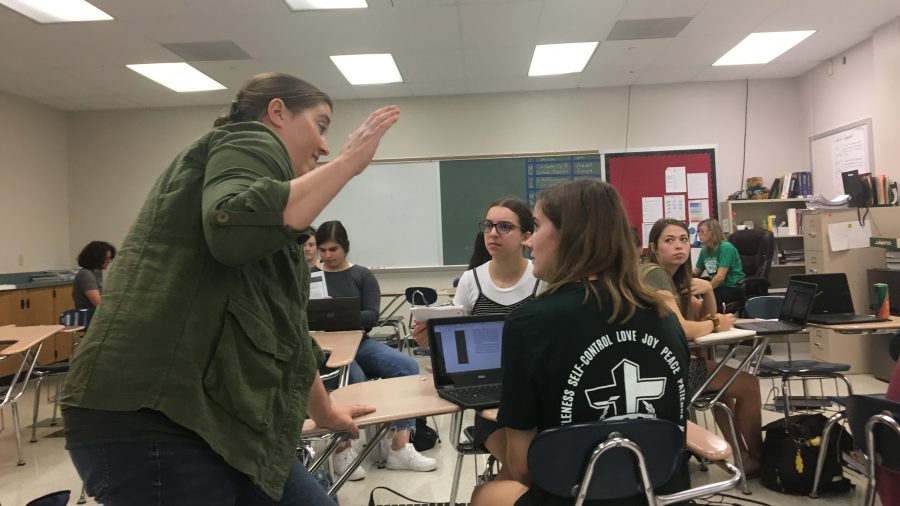Team-teaching is a concept important to the structure of the RBHS Civics Studies Department. Holly Kerns, an Advanced Placement (AP) Language and Composition teacher, works with AP U.S. teacher Kimberley Metcalf. In previous years, she taught speech and debate as well as theater classes. Although she has an English education, she has never taught the subject until now.
This is a year of firsts for Kerns, as she has never taught an English, AP or partnership class before.
“So far, partner teaching is an adventure,” Kerns said. “I have been used to being isolated, sometimes, in being the only person teaching a particular class, so the difference now in working with someone so closely is huge.”
Kerns said working with a new teacher requires a significant amount of collaboration to build a strong teaching foundation. She and Metcalf take lots of time in order to be deliberate when crafting lesson plans for the classroom.
“We are learning to appreciate one another’s strengths and develop rapport,” Kerns said. “I think my main experience includes a recognition that we have a lot to learn from one another and that really getting strong at what we do will take the whole year-long cycle.”
Alongside new teachers, veteran teachers are also an integral component of the team-teaching dynamic. Civics Studies teacher Benjamin Niewoehner has been part of different duos at RBHS for five years. The majority of his time spent in the classroom is with a partner.
Niewoehner has shared classrooms with two teaching partners during his time at RBHS. He and former partner Amanda Schirmer parted ways last year because of the influx of new staff in the Studies department, including Niewoehner’s current partner, Michael Pasternock. Civics Studies department chairs and administrators determined that each veteran Civics teacher would teach with an incoming teacher to impart some experience and wisdom.
One of the department heads who weighed in on this decision, Bree Anderson, said there are a number of variables that go into choosing duos. For example, the Civics department first must decide what grade level is appropriate for teachers to teach. This depends on their experience in the Studies content areas, as there is a difference between world history versus American government.
After the department figures out grade level, they then choose the partnerships. One of the considerations includes their ability to support new teachers, as they did with Pasternock.
First and foremost, department heads must make decisions based on student enrollment and section numbers. New partnerships sometimes form when teachers move from one level to another to make sure all the classes have teachers.
When teachers retire or leave RBHS, administrators also must hire new staff or recruit other teachers in the school, as they did with Kerns when Metcalf’s former partner retired. In addition to these reasons to form partnerships, Anderson also said the department allows teachers to give feedback on their fellow teacher or request a change for the following school year if they wish.
“Every decision we make revolving around a partnership is rooted in what we think is best for our students and classes,” Anderson said.
Junior Emma Dunlap enjoyed her team-taught classes because she appreciates the different subjects and viewpoints they bring to the classroom. However, she said this means focus is often placed on one teacher’s subject over the other.
“You’ll have one teacher dominating, and it’s generally studies,” Dunlap said. “These classes are more directed toward getting the history out there. That’s how I feel it’s been the last three years.”
Sophomore Shadid Shakhawat agrees with Dunlap that through co-teaching, students have access to two different educators, personalities and experiences. He said this reason is why the system is successful in his eyes.
“It feels nice knowing that there’s two teachers because there’s always help going around,” Shakhawat said. “Both of them bounce back ideas off of each other, and they both learn a little of each others’ topics, so they are capable of teaching us [different] topics from what they’re supposed to teach.”
As Shakhawat said, teachers can work together to plan lessons, but they also have their own interpretations of curriculum and teaching styles. From this, teachers model respect for differences, interdependence and conflict-resolution skills.
“It’s always fun to learn how to work with new people,” Niewoehner said, “and when you get along pretty naturally, it makes that process a whole heck of a lot easier and more enjoyable.”
Do you like having two teachers in one class? Let us know in the comments below!
Categories:
Partnership teaching shapes classrooms
September 19, 2019
0
Tags:
More to Discover













































































